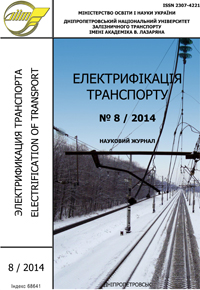Application of modeling and simulation techniques as methods for feasibility studies and design in electric traction systems
DOI:
https://doi.org/10.15802/etr.v0i8.42894Keywords:
electric traction, system, decomposition, modeling, routines, characteristic, time tableAbstract
The paper presents different aspects and approaches towards application modeling and simulation techniques. It is discussed the different approaches to the modeling of the traction power supply systems. ETS model has presented like a modular structure, and ETS as a complex system can be described by a finite number of subsystems. In this paper, the adopted methodology is considered to be a set of mutually dependent subsystems that simplifies the process of formulation, modification and computer implementation of models. The presented in the paper formal models have been applied in a form of software and implemented for simulation analysis of different 3 kV DC railway systems with a variety of traffic: suburban, mixed passenger and freight, freight, intercity to asses power demand and energy delivery adequacy of the designed power supply system during different feasibility studies. Some exemplary results of application of the derived methods are presented in the paper, showing opportunity for research and design in electric traction created by application of modeling and simulation techniques.References
Capasso A., Buffarini G.G., Morelli V., Lamedica R. Supply system characteristics and harmonic penetration studies of the new high speed FS railway line Milan-Rome-Naples. IEE Int. Conf. on Main Line Railway Electrification, York (UK), 1989.
Hill R.J., Cai Y. An efficient computational technique for a DC rail traction power flow simulation incoporating track branches. 6-th Int. Conference on Computational Methods, Italy, May, 1993.
Karwowski K., Mizan M. Zastosowanie programu PSPICE do badań symulacyjnych napędu przekształtnikowego sterowanego mikrokomputerowo. 3rd Int. Scientific Conf. MET’97 „Drives and supply systems for modern electric traction”, Warsaw, 25-27 September 1997.
Lewandowski M. Method of calculations of current harmonics in a current taken from 3kV DC network by a traction vehicle with asynchronous drive, Przegląd Elektrotechniczny, pp. 270-275, 6/2010.
Markvardt K. G. Energosnabženije električeskich železnych dorog. Moskva 1982.
Mellitt B., Passalaqua R., Sciutto G. The Role of CAE Techniques in Traction Systems. State of the Art and Trend. COMPRAIL’92, Rome, Italy, III, 1990.
Mouneimne Z., Mellitt B. Modelling of inverter controlled asynchronous drives for system simulation in DC railways. IEE Proc. Vol 135, Pt B, 5/88, pp. 210-217.
Pozzobon P., Sciutto G. Advanced Computer Simulation for Analysis and Design of Electrified Transportation Systems: Electric Plants and Drives. COMPRAIL’92, Waszyngton 1992
Rawicki S., Nowak M., Różański M., Wycinka W.: Calculation of energy-saving traffic of tram vehicle with field-oriented control of traction induction motors, Pojazdy Szynowe, 3/ 2011.
Szeląg A., Mierzejewski L. Ground transportation systems. Chapter in Encyclopedia ofElectrical and Electronic Engineering. Volume: Suplement I, John Wiley &Sons, Inc., NY, USA ,1999.
Szeląg A. Zagadnienia analizy i projektowania systemu trakcji elektrycznej prądu stałego z zastosowaniem technik Modelowania i symulacji. Prace Naukowe PW, Seria ELEKTRYKA, p.178, 123, 2002.
Szeląg A. Wpływ napięcia w sieci trakcyjnej 3 kV DC na parametry energetyczno-trakcyjne zasilanych pojazdów. Wyd. SPATIUM, Radom, 2013, s. 158.
Szeląg A., Maciołek T.: A 3 kV DC electric trac-tion system modernisation for increased speed and trains power demand – problems of analysis and synthe-sis, Przegląd Elektrotechniczny 3a(89)/2013.
Szeląg A., Patoka M. Issues of low frequency electromagnetic disturbances measurements In traction vehicles equipped with power electronics drive systems Przegląd Elektrotechniczny 9/2013, pp. 295-301.
Szeląg A., Steczek M. “Analysis ot input im-pedance frequency characteristic of electric vehicles with a.c. motors supplied by 3 kV DC system for reduc-ing disturbances in signalling track circuits caused by the harmonics in the vehicle's current”. Przegląd El-ektrotechniczny, 3a/2013.
Szelag, A. Analysis and computer aided model-ling and simulation of DC electric traction. Systems Sci-ence 18.4, 1993.
Szeląg, A., W. Zajac, Martinez P. M. "Harmonic distortion caused by electric traction vehicles with ac motors fed by DC supply system-CAD analysis." EPE-European Conference on Power Electronics and Appli-cations. Vol. 1. Proceedings. Sevilla, September 1995.
Szelag, A., and L. Mierzejewski. "An analysis of disturbances in power utility systems caused by traction rectifier substation." The 5th International Confe-rence on Computer Aided Design, Manufacture and Operation in the Railway and other Advanced Mass Transit Systems, COMPRAIL. Part 2(of 2). 1996.
Lewadowski M., Szelag A. Minimizing harmonics of the output voltage of the chopper inverter, Arch. Elektrotechnik, vol. 69, pp.223 -226, 1986.
Zając W., Szeląg A. Harmonic distortion caused by suburban and underground rolling stock with D.C. motors. CIEP 96, Cuernavaca, Mexico October 1996, pp. 14-17.
Altus J., Novak M., Otcenasova A., Pokorny M., Szeląg A. Quality parameters of electricity supplied to electric railways. Scientific Letters of the University of Żilina-Communications, No 2-3/2001.
Szeląg A. Verification of models applied in sim-ulation analysis of electrified railway lines - Weryfikacja modeli symulacyjnych systemu trakcji elektrycznej prądu stałego MET’99 Fourth International Conference on Drives and Supply Systems for Modern Electric Traction in Integrated XXI Century Europe, pp. 260-269, Warsaw, Poland, 1999.
Downloads
Published
Issue
Section
License
При направленні статті в редакцію, автор гарантує, що стаття надається для публікації уперше і раніше не була опублікована в інших виданнях повністю або частково.
Підписанням ліцензійного договору автор(и) підтверджує(ють), що має(ють) виняткове авторське право на статтю і передає(ють) невиняткові права на свою статтю видавництву журналу «Електрифікація транспорту» для публікації в черговому номері журналу. Автор(и) так само дає(ють) згоду на передачу і розміщення електронної версії своєї статті на сайтах баз даних, створюваних і поширюваних через Інтернет.
